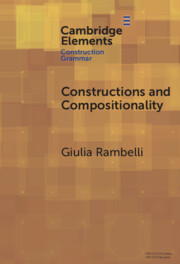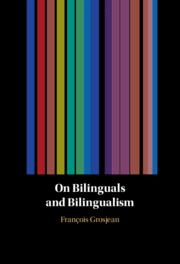Refine search
Actions for selected content:
46 results

Linguistic Illusions
- A Case Study on Agreement Attraction
-
- Published online:
- 30 October 2025
- Print publication:
- 02 October 2025
The processing of multi-word expressions: A research agenda for the next 10 years
-
- Journal:
- Language Teaching , First View
- Published online by Cambridge University Press:
- 27 August 2025, pp. 1-20
-
- Article
-
- You have access
- Open access
- HTML
- Export citation
Attentionally modulated motor-to-semantic priming: evidence from a property verification task
-
- Journal:
- Language and Cognition / Volume 17 / 2025
- Published online by Cambridge University Press:
- 06 August 2025, e61
-
- Article
-
- You have access
- Open access
- HTML
- Export citation
Small language models enable rapid and accurate extraction of structured data from unstructured text: An example with plants and their specialized metabolites
-
- Journal:
- Quantitative Plant Biology / Volume 6 / 2025
- Published online by Cambridge University Press:
- 25 July 2025, e26
-
- Article
-
- You have access
- Open access
- HTML
- Export citation
Chapter 14 - Autism
- from Part Four - How Music Helps with Illness
-
- Book:
- Good Vibrations
- Published online:
- 01 May 2025
- Print publication:
- 22 May 2025, pp 255-265
-
- Chapter
- Export citation
7 - What Role Does Explicit Learning Play in L2 Acquisition?
-
- Book:
- Key Questions in Second Language Acquisition
- Published online:
- 11 April 2025
- Print publication:
- 17 April 2025, pp 150-172
-
- Chapter
- Export citation
1 - The Cognitive-Functional Approach
-
- Book:
- Modality in Mind
- Published online:
- 25 March 2025
- Print publication:
- 27 March 2025, pp 7-35
-
- Chapter
- Export citation
7 - Back to the Cognitive-Functional Approach
-
- Book:
- Modality in Mind
- Published online:
- 25 March 2025
- Print publication:
- 27 March 2025, pp 233-270
-
- Chapter
- Export citation

Processability Theory
-
- Published online:
- 10 March 2025
- Print publication:
- 10 April 2025
-
- Element
- Export citation
Chapter 15 - Reducing Surprisal and Entropy
- from Part III - Mathematical Theories
-
- Book:
- Looking Ahead
- Published online:
- 20 March 2025
- Print publication:
- 06 March 2025, pp 163-173
-
- Chapter
- Export citation

Constructions and Compositionality
- Cognitive and Computational Explorations
-
- Published online:
- 17 December 2024
- Print publication:
- 30 January 2025
-
- Element
- Export citation
The how and the when of semantic illusions in native and non-native languages
-
- Journal:
- Language and Cognition / Volume 16 / Issue 4 / December 2024
- Published online by Cambridge University Press:
- 07 October 2024, pp. 2105-2129
-
- Article
-
- You have access
- Open access
- HTML
- Export citation
Uncovering echoic mechanisms in verbal irony comprehension
-
- Journal:
- Language and Cognition / Volume 16 / Issue 4 / December 2024
- Published online by Cambridge University Press:
- 07 October 2024, pp. 2148-2168
-
- Article
-
- You have access
- Open access
- HTML
- Export citation

On Bilinguals and Bilingualism
-
- Published online:
- 08 February 2024
- Print publication:
- 15 February 2024
5 - Literacy and Language Issues and Strategies
- from Part II
-
- Book:
- Succeeding and Adult Dyslexia
- Published online:
- 11 January 2024
- Print publication:
- 01 February 2024, pp 138-167
-
- Chapter
- Export citation
Frequent vs. infrequent words shape toddlers’ real-time sentence comprehension
-
- Journal:
- Journal of Child Language / Volume 51 / Issue 6 / November 2024
- Published online by Cambridge University Press:
- 04 July 2023, pp. 1478-1488
-
- Article
-
- You have access
- Open access
- HTML
- Export citation
9 - Comparing the Three Heritage Languages
-
- Book:
- Native Speakers, Interrupted
- Published online:
- 15 December 2022
- Print publication:
- 22 December 2022, pp 227-260
-
- Chapter
- Export citation
Control in a Norwegian grammar maze
-
- Journal:
- Nordic Journal of Linguistics / Volume 47 / Issue 2 / October 2024
- Published online by Cambridge University Press:
- 30 September 2022, pp. 121-158
-
- Article
-
- You have access
- Open access
- HTML
- Export citation
5 - Language and Thought in Multilingual Children
- from Part Two - Cognition and Faculties in Multilinguals
-
-
- Book:
- The Cambridge Handbook of Childhood Multilingualism
- Published online:
- 18 August 2022
- Print publication:
- 25 August 2022, pp 113-140
-
- Chapter
- Export citation
1 - At the Intersection of Cognitive Processes and Linguistic Diversity
-
-
- Book:
- Morphological Diversity and Linguistic Cognition
- Published online:
- 19 May 2022
- Print publication:
- 02 June 2022, pp 1-28
-
- Chapter
- Export citation
